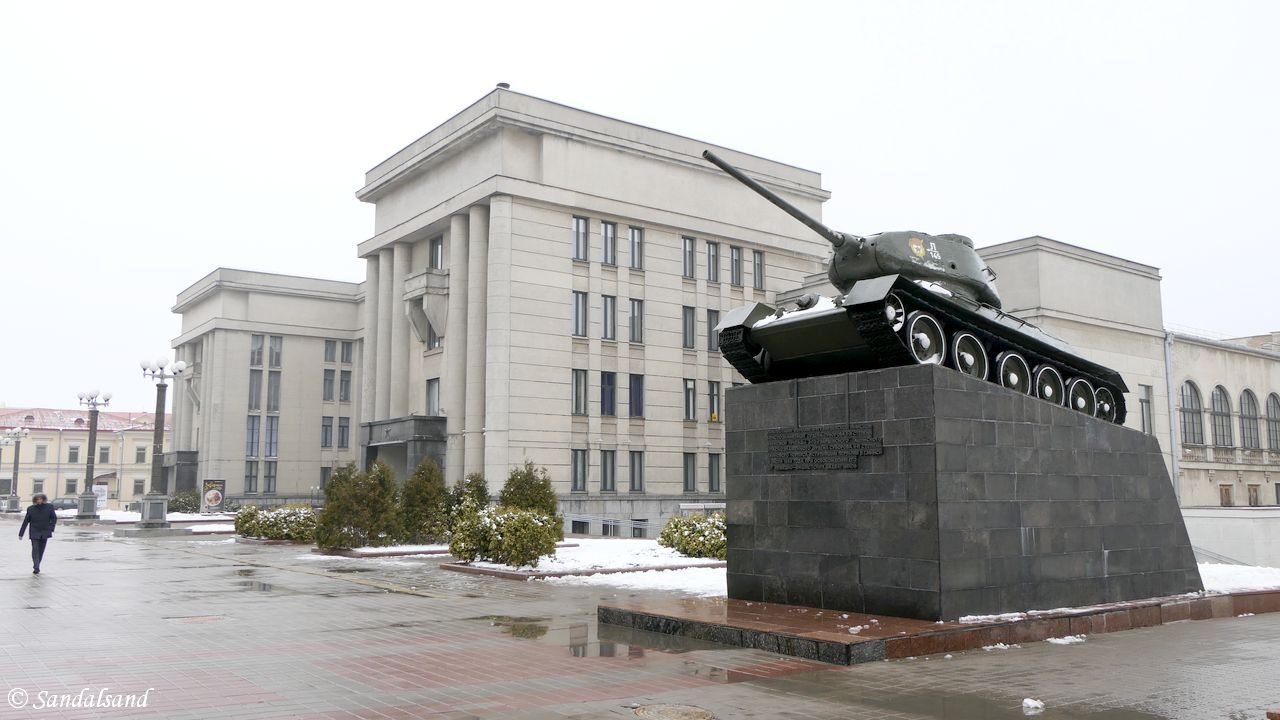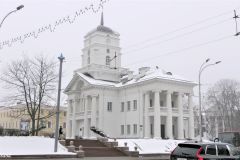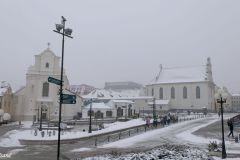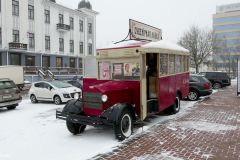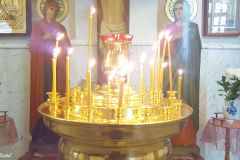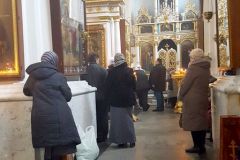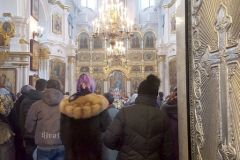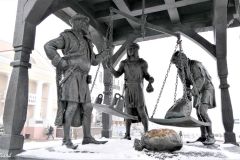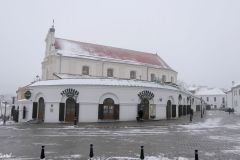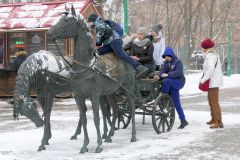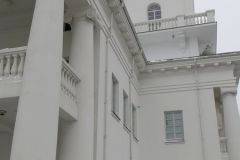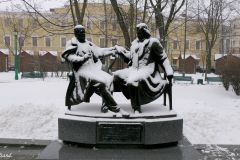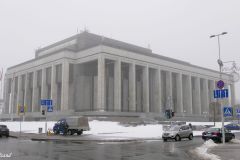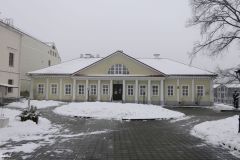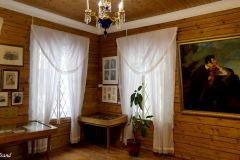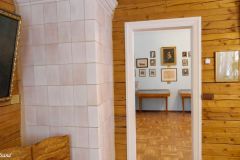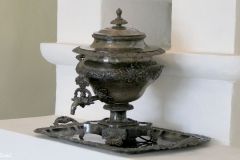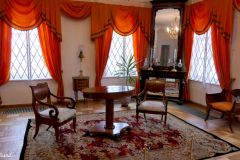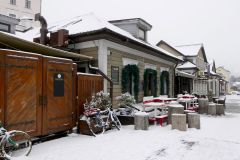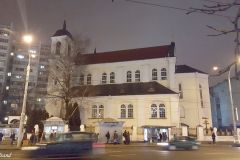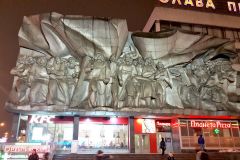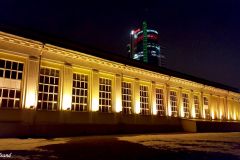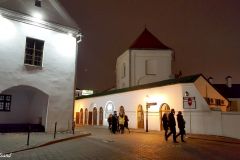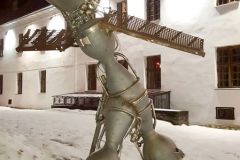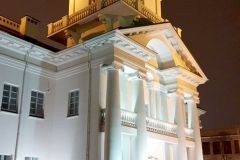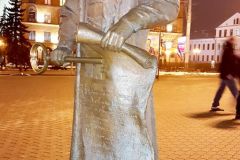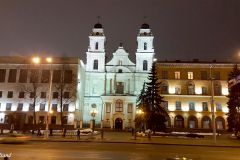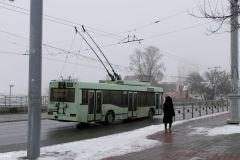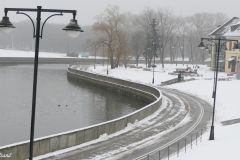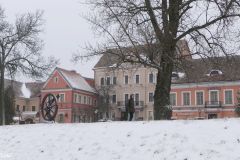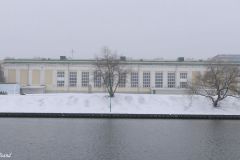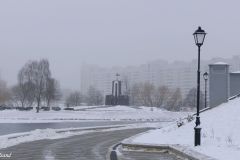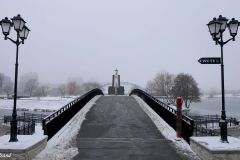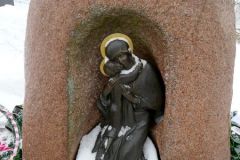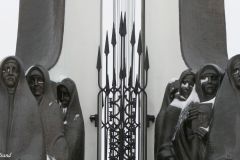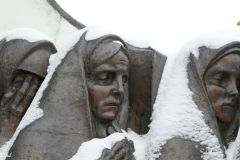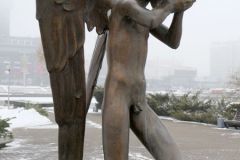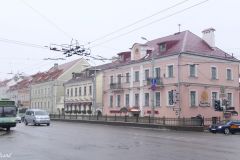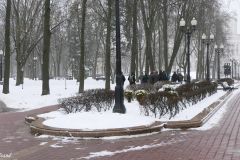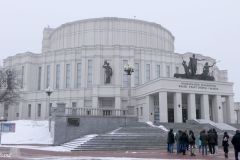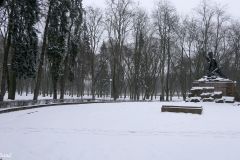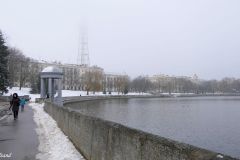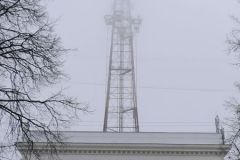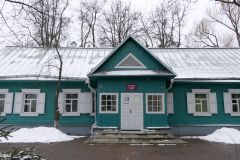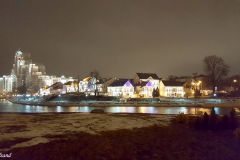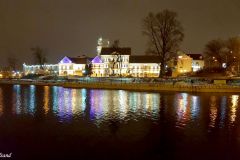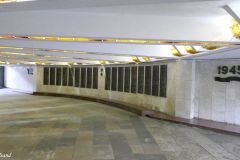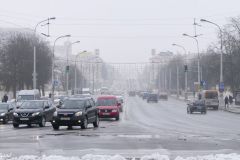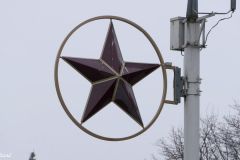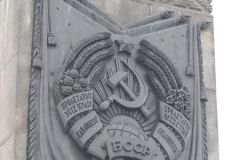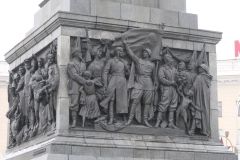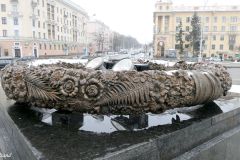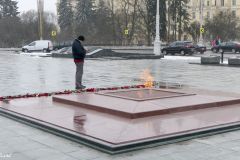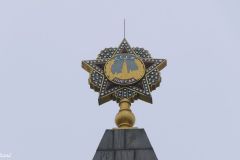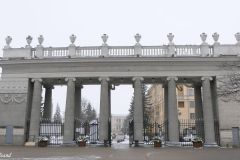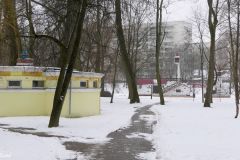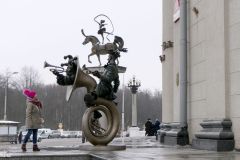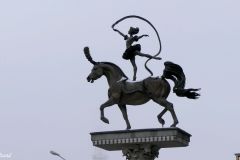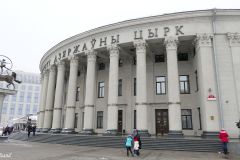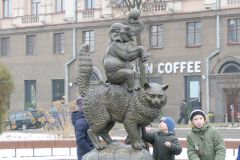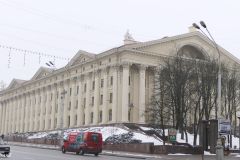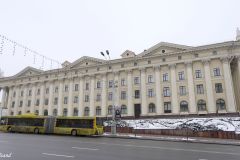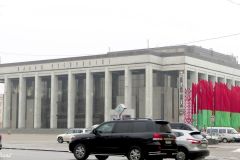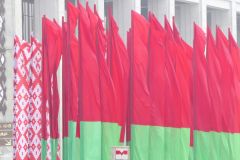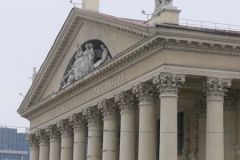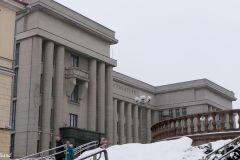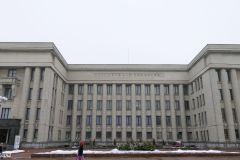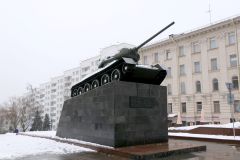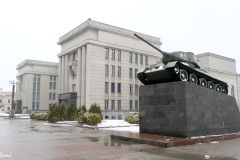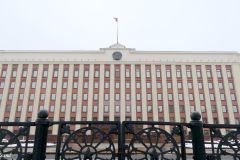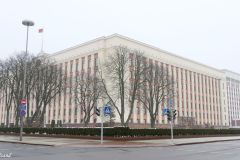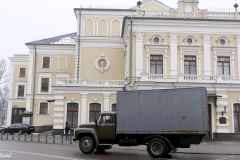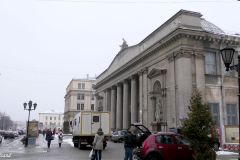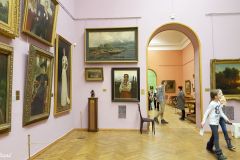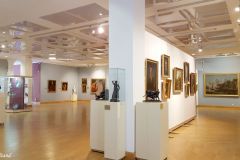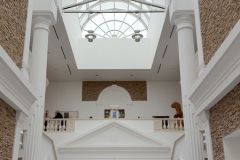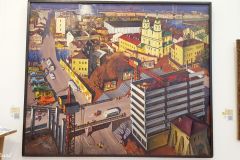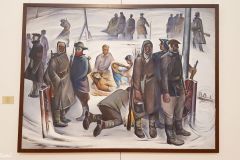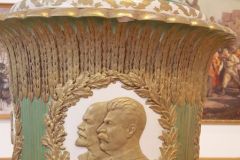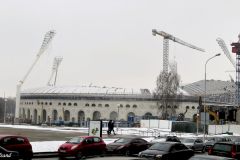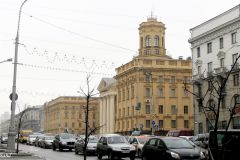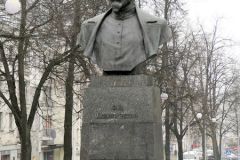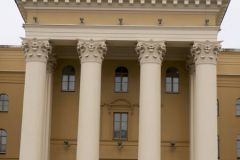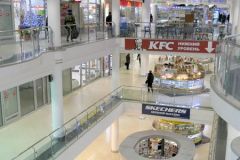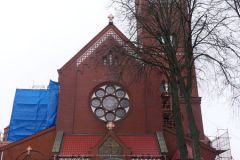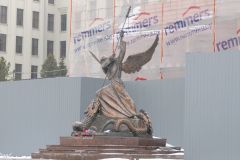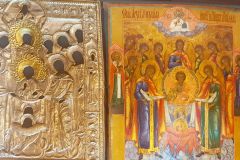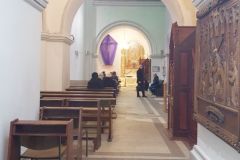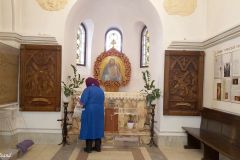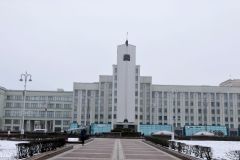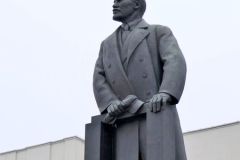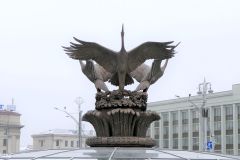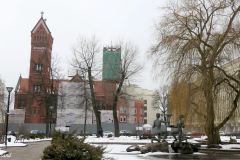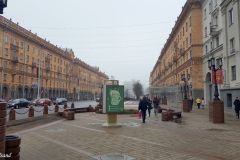I will start with a brief introduction to Belarus, and spend most of the article promoting a do-it-yourself walk in central Minsk.
First, a short introduction
Belarus has a population of about 9,5 million, of which more than 2 million live in the capital of Minsk. It became an independent republic in 1991 following the dissolution of the Soviet Union.
Before 1917
For centuries the territory now recognised as Belarus was dominated by foreign powers, including the Principality of Polotsk (11th to 14th centuries), the Grand Duchy of Lithuania, the Polish–Lithuanian Commonwealth, and the Russian Empire. After the Russian revolution in 1917 there was a short period in which the Belarusians declared independence only to be reconquered by the new authorities in Moscow. In the ensuing years the Byelorussian Soviet Socialist Republic existed as a republic within the USSR.
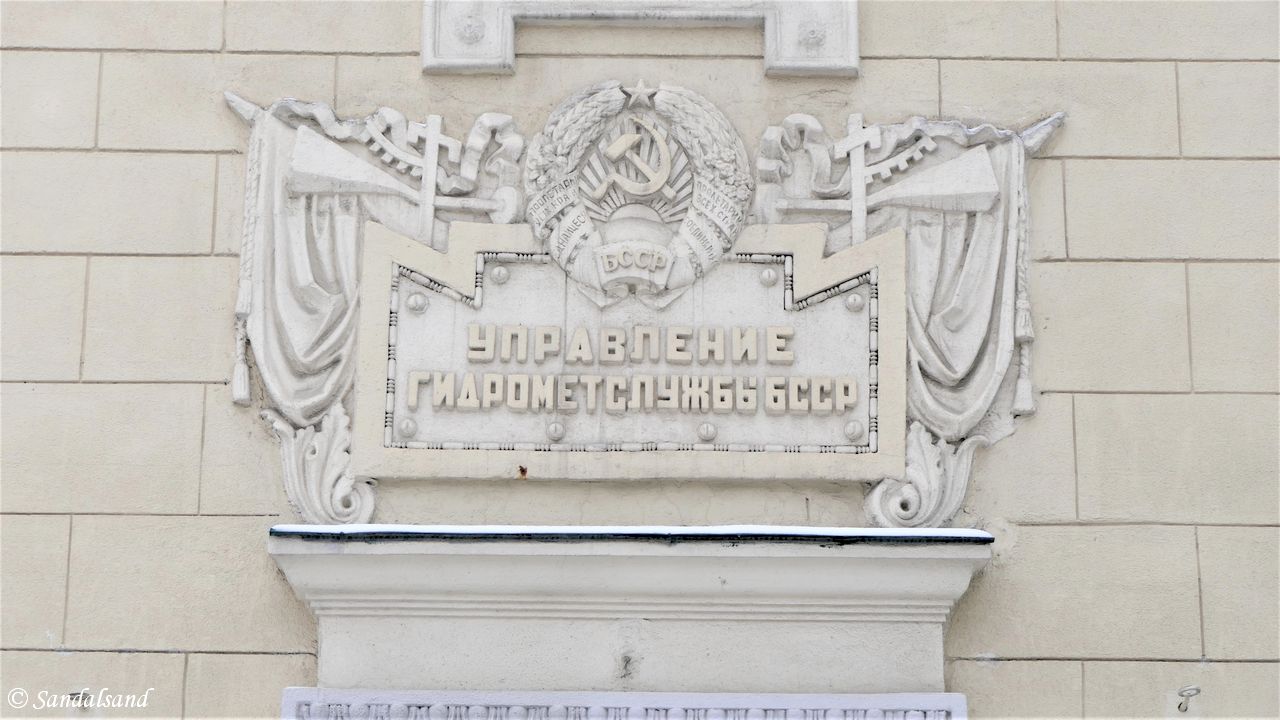
Artwork from the postwar period is found many places. This one is photographed in Ulitsa Komsomol’skaya, or Young Communist’s Street. The old street names in central Minsk have survived.
Independence after 1991
In 2000, Belarus and Russia signed a treaty forming the Union State and all since 1994 Alexander Lukashenko has held the position of president of the republic. The close relationship between Moscow and Minsk, in combination with the authoritarian rule under Lukashenko has earned Belarus some doubtful nicknames in the West: Europe’s last dictatorship and the last Soviet state. The latter is certainly a label very much contested by the stan-countries to the south of Russia. Some sharp tongues have also claimed that Belarus and its people still haven’t realised that Communism was terminated and the Soviet Union dissolved in 1991.
Politics aside, Belarus is a forested country with more that 40% of its territory covered by trees. More than two thirds of its population live in urban areas and more than 80% are ethnic Belarusian. There are two official languages – Belarusian and Russan. English is generally not spoken or understood. There is an open border with Russia and Russians view Belarus as a popular destination.
The inhabitants of Belarus suffered heavily in the first decades of Communist rule, and a lot worse because of the Nazi invasion. 209 out of 290 cities were destroyed and 2-3 million people were killed, almost a third of its population. By the end of the war 80% of the buildings in Minsk lay in rubble. There was a debate on whether they should build a completely new city outside the destroyed one. The debate ended with a compromise. It was partly reconstructed but essentially rebuilt with Soviet style wide avenues, large squares and monstrous buildings.

The very long (15 km) and wide Independence Avenue (Praspiekt Niezaliežnasci) seen from Victory Square.
Map of attractions in Minsk
This article will deal with sights inside the historical city centre of Minsk. I made a map before going there, added places while I was there and finished it when I returned home. Feel free to expand the map into a new window, click the markers and follow my suggested walk in central Minsk.
About this walk in central Minsk
The walk in central Minsk is about 7 km long and would normally take a full day. You could do it in less, or split it into two. There are a couple of museums on the way, but most markers on the map are from sights that would not take too long to visit. It all depends on your appetite for museums, historical landmarks, architecture, social life, food and whatsoever.
The Vierchni Horad area (Upper Town)
The Upper town area in what used to hold the oldest buildings in Minsk is a perfect place to start your walk. The imposing City Hall with its white-washed facade and columns boasts a proud history. It was in fact inaugurated as late as 2004. It was however reconstructed according to how it stood before the Russian emperor ordered it demolished in 1857. There are several bronze sculptures around the hall, in the park and towards the large church overlooking the Svislach River.
Enjoy the river view and then enter the Holy Spirit Cathedral. This is an easily recognisable building with two towers. It was built in 1642 as part of a convent. Over the next centuries it suffered fires and neglect, and a change of purpose in the days of Communism. Today it has been restored. It is an active church so spend some time inside to watch the worshippers coming by for prayer at the icons. This is a Russian Orthodox church.
From here I suggest you walk past the huge Palace of Republic serving various official purposes. I found it more interesting to spend a few kopeks for a look inside the House of Wa?kowicz family. The family’s patron is famed for being the most important Belarus painter of the 19th century. The museum displays period paintings, photographs and furniture.
In the night this area transforms into a different scene with bars and restaurants. My visit was in late March but I can vividly imagine how popular it will be during the summer months.
The Trinity Hill area and beyond
We are on a walk in central Minsk. Now head for the river and cross it. Here we encounter what is called the Old Town. It has certainly been reconstructed in recent years, but it holds a resemblance to what it must have looked like in the past. It is a charming area, perhaps especially so in summer. I walked along the river bank and crossed a small footbridge.
The Island of Tears has several monuments erected to commemorate Belarus soldiers killed during the war in Afghanistan (1979-1989). At the centre there is a small chapel and bronze figures of mourning mothers, sisters and widows. Next there is a statue of a young boy in the shape of an angel.
Our walk continues over the hill and into the park surrounding the National Academic Bolshoi Opera and Ballet Theatre. If you find time, see if you can get hold of tickets for a performance. I did not, but I walked past it through more parks and statues. Inside the park I followed the river, looked up on the TV tower and rounded the corner of building now housing the Museum of First Congress of the Russian Social Democratic Labour Party. This is one of the oldest museums in Minsk and falls in my view into the special interest’s category.
Sights on or off the Praspyekt Nyezalyezhnastsi (Independence avenue)
Victory Square
The very long Independence Avenue runs straight through the city centre. At the Victory Square it runs around the Victory Monument. There is no doubt, this monument truly lives up to its name. To get across to the monument you will have to find an underpass and then you will face a huge 38-metre granite column with a 3-metre high replica of the Soviet Order of Victory on top. The column has four huge bronze reliefs at the base and next to the column there is an eternal flame coming up from the ground. The victory in question is of course the one over the Nazis in what is called the Great Patriotic War in this part of the world.
For the remainder of this walk we are following more or less the avenue. The first deviation is at Gorky Park. This is the oldest in Minsk (1800) and has seen many changes over the years. Today it is popular not least among children. There is a Ferris wheel and an observatory and planetarium. I merely settled for a walk through some of it and wound up behind an interesting building.
The Belarusian State Circus houses just that, and reminded me of how important circuses are in Eastern Europe in particular. Have a look at the statues outside.
Soviet style buildings
Coming up along or near the Independence avenue are several Soviet style buildings. The first is the Trade Union Palace with a more classical look with columns, then the Palace of the Republic mentioned earlier. To our right we have the Aliaksandra?ski Garden Square, a formal garden structure. It is flanked on the side where we are coming from by the austere looking Central House of Officers and the Tank Monument next to it.
On the other side of the Alexander Square we pass by the huge Presidential Residence which does not offer any welcoming greetings. We hastily continue our walk past a theatre and a cafe (read the next article in this mini-series) before ending up with something completely different.
The Belarusian National Arts Museum contains the largest collection of Belorussian and international art in the country. I would highly recommend a walk through the exhibition halls inside, taking note also of the interior architecture employed in the extension of the building.
A department store and KGB
Back on the familiar avenue we bump straight into the large Gum Department Store. It is not quite the same calibre as its namesake in Moscow. Still, it retains the charm of the good old days when a well equipped department store was for the chosen few. Today, there is a way to go in terms of how goods are displayed in the various departments.
Coming up next is a huge palace-looking structure simply called the KGB Building. It still houses the KGB, and the KGB still have not changed its name like in Russia. Across the street there is a statue of the man who established the first secret police in the USSR, Felix Dzerzhinsky.
If you walk down the garden behind the statue and turn right you will find the Belarusian National History and Culture. I did not go there. Anyway, this concludes this part of our walk. We are on to the final section, but first some pictures from the places mentioned above.
The Independence Square
After a long walk we finally get to the huge Independence Square. First we might take a walk underneath it through a shopping mall. The interesting parts are certainly above ground consisting of a series of monumental buildings of national importance. The buildings house the city council, the university and the supreme Soviet. In front of the latter stands a large statue of Vladimir Lenin.
The Red Church is also situated here. It is of a totally different character. This is a red brick Catholic church from around 1910. The Soviets turned it into a cinema and later a film studio. Now it has regained its original functions.
The Independence Avenue, or at least the 2,5 km stretch I have presented from Victory Square to Independence Square, is filled with Socialist Realist architecture – also labelled Soviet or Stalinist architecture. It was built over a 15 year period after the end of WWII. The characteristics vary, from the classicist examples with large columns on the facade to the ones with symmetrical grey and rather flat concrete structures.
In fact the Belarus government submitted in 2004 an application to UNESCO in order to include this ensemble on the World Heritage List. Following discussions it was removed from the tentative list in 2015. That is a pity, for there are still no Soviet architecture on that list, and I would suppose the Praspiekt Niezaliežnasci would make a fine example.
Read more
I hope you liked this walk in central Minsk. The charming parts of central Minsk are made up of the old town(s) and the parks and gardens scattered around. The less charming parts are the post-war monumental Soviet style structures. Even they make it interesting to visit Minsk, not least for a glimpse into a not too distant past. I found it very easy to get around, on this walk in central Minsk, and would like to think that a summer visit would leave an even better impression.
There is a second article from Minsk presenting other highlights in the city centre, above and below ground. Find accommodation, restaurants, and practical information about how to get into a country that previously was closed.
Read all articles from Belarus.
